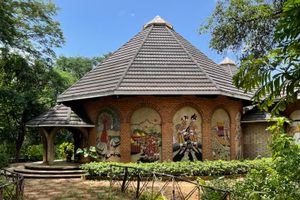Nestled between the Dedza-Salima Forest and the shores of Kasankha Bay of Lake Malawi is the Mua Parish Mission, home to the Kungoni Centre of Culture and Art. It’s the most extensive museum complex in Malawi, a vast repository of the nation’s history, culture, and art.
The mission dates back to 1902, when three “White Fathers” (Catholic priests dressed in white robes) arrived in Mua. They settled under a baobab tree in the spot now marked by the centre’s Chamare Museum. But it wasn’t until 1976 that Father Claude Boucher Chisale expanded the mission into a cultural center. Today, it includes the museum with its four frescoed buildings, a botanical garden, a dance/ceremonial boma, an art gallery, and a shop.
The Chamare Museum showcases the cultures of three major Malawian tribes: the Chewa, Yao, and Ngoni. Visitors are greeted by statues of Father Jean-Baptiste Champmartin (known locally as “Chamare”) and Bishop Cornelius Chitsulo, Malawi’s first African bishop. In front lies a collection of traditional musical instruments used in the centre’s dance ceremonies, while the surrounding walls tell the story of the mission and Malawian culture through a “tree of life” theme. Look closely for chameleon images, as they are revered symbols of long life.
Other galleries brim with colorful masks and effigies bedecking the rooms from floor to ceiling. Because of the sensitive nature of the materials, photography is not permitted in most rooms of the museum.
Another highlight is a diorama of Makewana, the female rainmaker from ancient Malawian stories, depicted in the midst of an ecstatic vision with wildly long hair and nails, the cutting of which would bring drought.
Visitors can wander the impressive gardens, frescoes, and sculptures, or head toward the Nadzipokwe River to see the waterfall. The shop features carvings by Malawi’s top artists at local prices, and some can be commissioned to reproduce pieces from the permanent collection. Woodwork, one will quickly realize, is the heart and soul of the centre.
